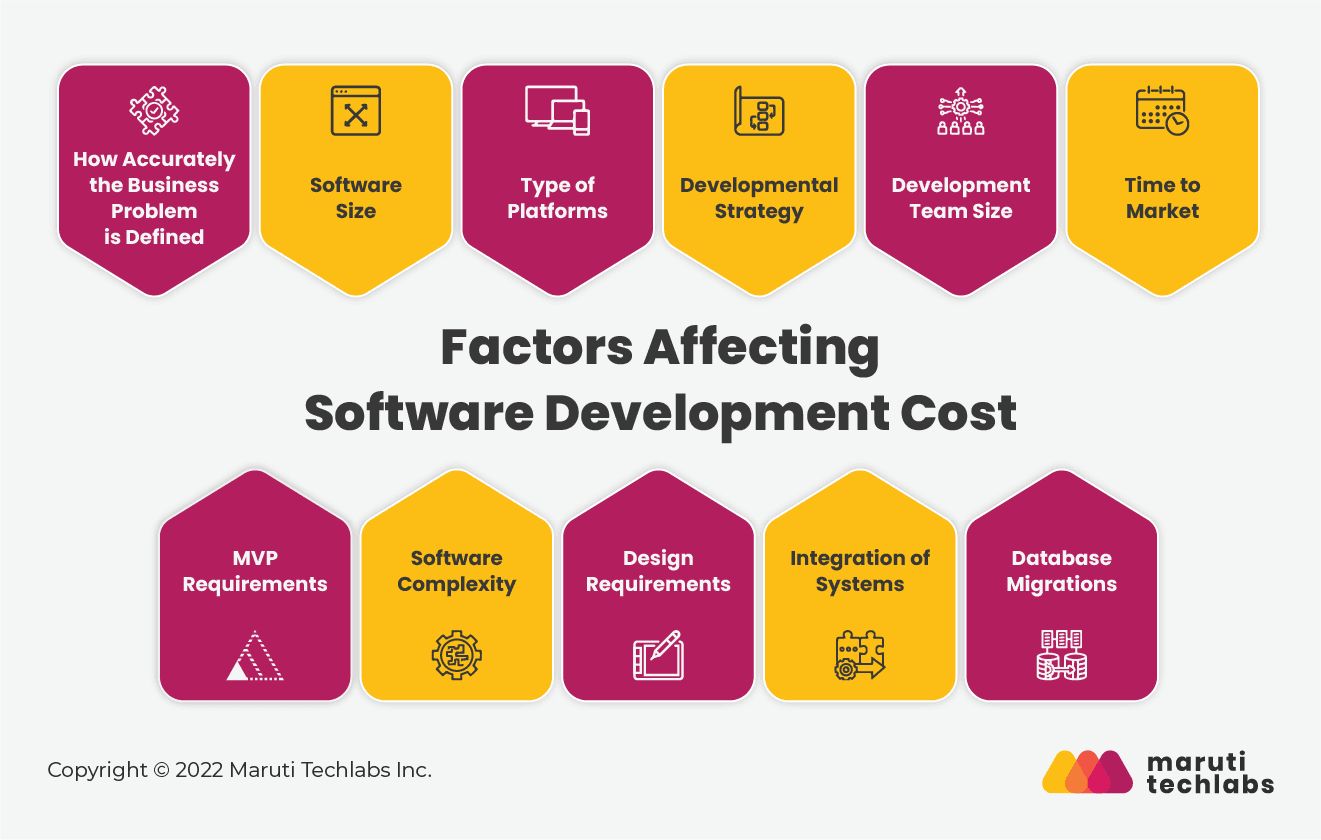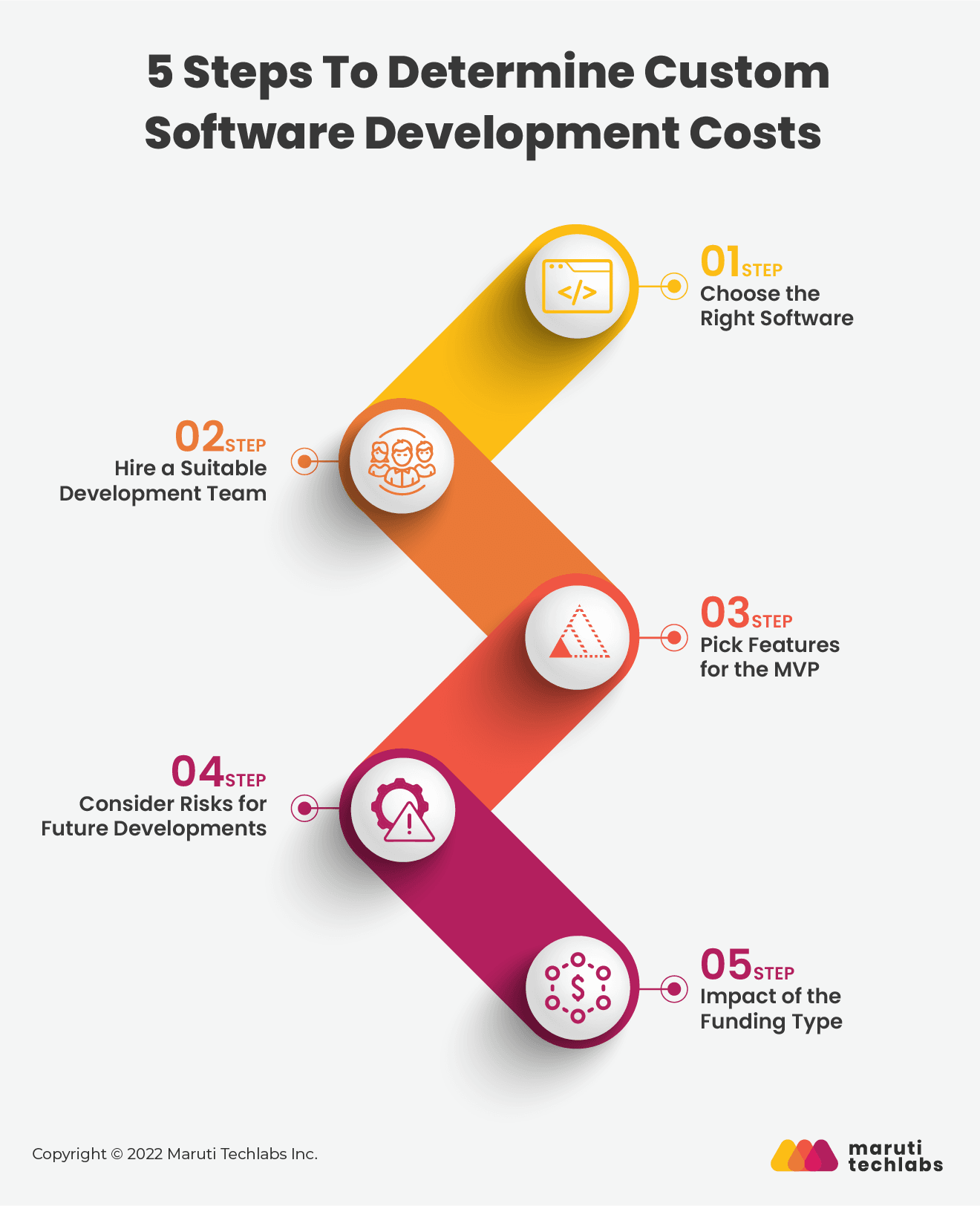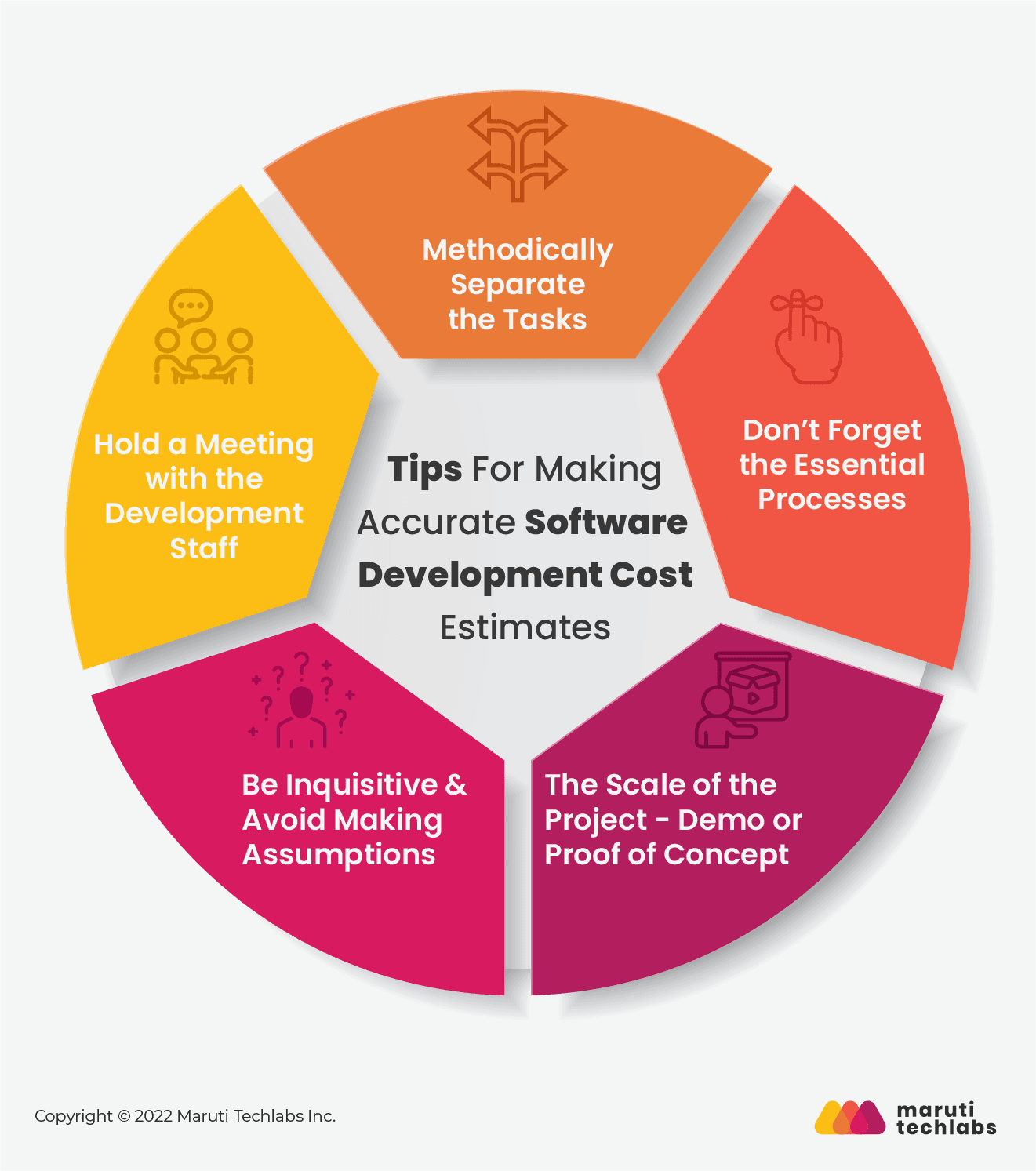

How to Estimate Custom Software Development Costs? A Comprehensive Guide






The concept of a "one size fits all" solution is fading as businesses across various sectors realize the value of investing in custom software development services.
There has been a massive spike in the popularity of custom software development. However, first-time entrepreneurs can’t risk estimating costs for their custom software development project.
Maruti Techlabs and some of the world's top IT executives have been featured on the prestigious GoodFirms Leaders Roundtable Podcast. During the podcast, our visionary CEO & Founder, Mr. Mitul Makadia, shared his valuable insights and expertise on how to build a cutting-edge software development company that is equipped to thrive in the future. Listen in to discover everything you need to know about software development startups!
When consulting with a development team, one of the first things they ask is, "How much does custom software development cost?
However, there is no definitive answer.
The time and resources needed to implement your idea will vary depending on whether you're developing a single-feature product or an entire internal business system.
Many variables affect final costs, such as the customer’s experience and the project's software, technology stack, and infrastructure complexity.
When estimating the custom software development costs, there are undoubtedly hundreds of issues to address apart from the costs. And that's presumably why we’ve written this blog: to guide you through estimating software development costs.

The system requirement specification (SRS) or Business Requirement Document (BRD) is a comprehensive list of all the features and non-features that must be included in the software you plan to develop. Understanding all the requirements before starting development is essential to avoid any surprises or costly changes further down the line.
These two documents estimate the time and money needed to finish the project by subdividing the high-level BRD into core modules, submodules, and features. This will help define the business problem and give better estimates from there.
One way to get a ballpark figure for the average cost of custom software development is by looking at its size. The larger the scale of your project, the more money you will need to spend on it. The software’s size will significantly contribute to the average price of custom software development from scratch.
Most startups debut with a minimal viable product (MVP), using a lean and frugal approach to product creation. Their products are more manageable and aimed at a more select audience for beta testing.
In contrast, few businesses need a more extensive workforce to develop their software. They must deal with intricate procedures, internal mechanisms, and other necessities. Aside from that, one may need medium-sized or small-scale applications for their business.
They may require lightweight software such as a website, web app, single-page application, or comparable service. The custom software development costs can be estimated based on the scope of your project.
The custom software development costs could change if you use a different development environment. Android, for instance, is one of the most well-liked platforms right now since it has successfully broken into previously untapped device categories, such as laptops, broadcasting tools, wearables, and even household appliances.
However, scalability increases significantly when a large platform such as Android is used. The efficient performance calls for a well-built software architecture, which means extra work for the developers.
Let's get a grasp on this from a business standpoint. An organization uses Android to roll out application software but later decides it also needs support for iOS and Windows.
A dedicated team of programmers is required for each native environment in which software is released. Having more than one development team will increase your custom software development costs.
While doing this, a cross-platform development method allows the code to be used on several native platforms. This eliminates the need to create separate development teams for every platform.
The time and money required to develop unique software can be cut in half by reusing existing code. The custom software development costs also vary depending on the software deployment technologies used.
If, for example, you decide to use automation for simultaneous implementation and deployment, while the upfront cost is significant, maintaining it goes down over time.
Each module of your project plan contributes to a more comprehensive view of the strategy and resources that will be put into carrying out the project, from picking a framework to implementing a development approach.
When you've completed that, you'll want to move on to a method of development that is quick, dependable, and error-free. One such method that employs iterative steps is known as agile development.
As per research, 95% of respondents claimed that their firm utilized Agile development to reduce the average cost of custom software development. Tasks are divided between sprints to accommodate feedback from stakeholders and engineers.
The size of the app development team depends on the project type, budget, and time required to develop the project. Every software development company hires experts as per their project requirements. If the project needs more resources, they hire more people, which results in higher app development costs.
Additionally, some companies hire in-house developers for their software development needs. In this case, the cost of software development will be high.

One of the widely popular ways is to recruit an extended team from a reputed IT staff augmentation company like ours. This helps minimize the cost of custom software development.
Many factors in the development process can impact the time-to-market. Every aspect, from the size of the software to the number of features it contains, affects the delivery schedule.
Time-to-market is a significant issue in each of the above scenarios. Not knowing when your brilliant concept may get stale is a considerable worry for startups and established businesses. Therefore, getting to market quickly becomes crucial.
Many companies prefer partnering with IT outsourcing solutions providers to accelerate their time-to-market without compromising on quality. Our highly skilled team of developers and testers work dedicatedly on your application to expedite your development cycle.
The Minimum Viable Product (MVP) is an excellent approach to test your ideas before they enter the marketplace and get helpful feedback.
The time and money spent creating a minimum viable product (MVP) can account for approximately 20–40% of your development budget. Still, it's well worth it because feedback from early adopters can help you fine-tune your product. In addition, you'll have more time on your hands to focus on the more complex aspects of the app's design.
Outsourcing MVP development has helped many startups get started without investing excessive resources. SeatGeek, Groove, Whatsapp, and Slack are well-known brands that outsourced their MVP. By outsourcing MVP development, businesses can keep the software development cost high; moreover, they can bring the best talent to the role with their team.
It's normal to feel unsure whether to put extraneous features off until subsequent updates or focus on thoroughly testing the most crucial ones. However, here's the thing: think about a software program with complex features that necessitate a lot of computing and processing power.
The software’s backend must be robust, which may result in higher custom software development costs than the average. The software's complexity increases as more and more people are brought in to evaluate its usability.
Additionally, organizations need help to equip different software in their system simultaneously. Custom software solves this issue by being scalable, flexible, and easy to maintain for a single user.
It is more cost-effective to develop bespoke software that meets specific needs while having a straightforward structure. Focusing on functionality rather than appearances is a crucial improvement that simplifies these complexities.
It saves money and redirects resources to other vital projects. Minimal design is easier to maintain across software versions, which reduces the time spent developing.
Framing software with innovative animations and creative designs is always the best bet because it keeps the users engaged with your product. Therefore, design has great potential for your project's development efforts, which can quickly spike the software development cost.
It's important to create visually appealing user interfaces. However, simplicity is also key. One way to achieve both goals is to create a design that quickly and efficiently navigates users to your services.
The next most influential factor is your custom software's complexity and the number of required system integrations. There are very few stand-alone software solutions. Most software requires integration with a third-party service, an application programming interface (API), or an organization's pre-existing suite of legacy software.
Integrating your unique software with an outdated legacy application may be more expensive than integrating with third-party apps or widely used APIs. It is also necessary to develop new Application Programming Interfaces (APIs) for some programs before they can be combined correctly. This would affect the final custom software development costs as well.
Teams developing custom software must effectively make a copy of the current data and migrate it to the new database. The cost of custom software development increases with the size of your database, the complexity of its security needs, and the number of known vulnerabilities in your system.
Validation, data conversion, cleansing, analysis, security profiling, and quality assurance are some tasks that must be completed during a database migration, and the software development team must take care of them all. The sum of these factors typically raises the average cost of custom software development.
When it comes to developing a custom software project, understanding the factors affecting the cost is essential to avoid any surprises or costly changes further down the line. Therefore, choosing the right mobile app development company is crucial to ensure these factors are considered and the project is completed within the expected budget.

Many small and large businesses need help using a preconfigured product or developing their unique software. When compared side by side, the off-the-shelf software appears to be the clear winner; nevertheless, there is more to the story. Take an unbiased look at this:
Finding a solution that meets your unique requirements can take time and effort. You could go with ready-made software that fits these requirements, and it would even seem like a blessing, but what if you later decide to expand the system's capabilities?
Tasks like integration, maintenance, upgrades, and training are just the beginning. No hidden expenses are associated with custom software development for your organization.
Involving developers in software development can be done in two ways:
When you hire an in-house developer, you may be responsible for their health insurance, productivity measures, benefits, and allowances. You will spend a lot of money on new resources.
On the contrary, the custom software development costs associated with employing a full-fledged staff of offshore software developers are minimal. Experts in the relevant field will join your team to help you advance the project.
The benefits of software development outsourcing don't stop at having an extra set of hands to help you with your product development. You can also work with an extended team that can assist you depending on where you are in the product development journey- whether you have an MVP that needs to go to market and find product market fit or scale an existing product to handle the volume. With a team at your disposal, you can focus on what you're good at and leave the software development to us. It also allows you to tap into a larger pool of talented developers.
Examples of offshore tech teams include:
Prioritization is essential to maximize the return on investment (ROI) through features. You'll need to improve the features if you want more people to utilize your product. While outlining the needs of your project, you can divide its aspects into two groups: high and low priority.
You can emphasize your app's essential features when building a minimum viable product. It reduces custom software development costs and scales down the time to market, relieving pressure on your team.
When you build a large-scale product, it's essential to weigh the odds. Neglecting the size of your scalability can have far-reaching effects, including losing credibility with your user base in some situations.
The average cost of custom software development is relatively low, and the design of small-scale software is fairly straightforward. In contrast, enterprise-level programs require a much more significant financial investment due to their extensive functionality. This distinction makes the two programs' respective custom software development costs different.
A lot of money is needed to develop enterprise-level software, and here is where the idea of grant money comes in. Funding from philanthropic groups, government agencies, and similar organizations makes grant-funded software extremely scalable.

How can you divide up larger projects? You can better assess your needs by dividing large projects into manageable chunks. You will have a better chance of answering other questions relating to software development.
Here's an instance:
The custom software development cost estimates you derive from the task descriptions are crucial. When working with a development team, it's critical to determine their strategy for getting things done.
Asking the right questions improves communication and helps you understand how the software development cost relates to the process. With this information, you can make more informed decisions about your project.
In most cases, you and your development team will have different understandings of how much time and money something will take. The most important thing is to keep your development team together.
You can always ask your project manager these clarifying questions to gain a firmer grasp of the situation:
For successful software development cost estimation, you should keep the actual software development process in mind, such as -
All the processes mentioned above are essential in software development cost estimation.
The cost estimates for software development will also depend on the scale of the project - is it a demo or a POC?
When it comes to POC, it should engage all parties involved in project development. It is vital with the goal that app partners can quickly settle on the opportunities, associated risks, software development strategy, and final product vision. That makes the POC a strong support for your project's plan, without which you should never start your software development processes. Conducting a technical feasibility study will help determine whether or not the software is worth the investment and how much it will cost to make any changes to the original design.
The three main categories are enterprise, mid-market, and small-scale software. Custom software development costs are affected differently by each category and what category the business falls in, whether it is an early-stage startup, SMB or enterprise. Custom software development costs are affected differently by each category.
Enterprise-level custom software development costs are anywhere from $750,000.00 to $2,000,000.00.Alternatively, small-scale software costs you between $ 40,000.00 to $500,000.00, while mid-market software costs between $ 200,000.00 to $1,000,000.00.However, it is important to note that these figures are for a single project only and can change depending on the scope of work, timelines, and teams deployed on development.
Your technology partner's location will determine the hourly rate you'll pay. For example, the custom software development costs in the United States are typically more than in Europe or India. In addition, the overall custom software development costs tend to rise for software companies working on a massive scale because more time and money must be devoted to the endeavor.
Each project has unique requirements, but how does that affect the hourly rate? It is standard practice for any software development firm to staff up according to the scope of your project.
The cost of custom software development will go up when more experts are hired to complete a project. The price also varies depending on the project's nature, scope and size. Consider all these factors if you plan on using your in-house developers.
Suppose you require a Project Manager, QA Analyst, Frontend Developer, and Backend Developer at the average rate of $40/hour(the individual rates may differ from person to person based on skills and experience; however, we'll average it out for the sake of this example). Working at 100% capacity would amount to $20,000/month (8 hours/day, except for the Technical Project Manager, who would only be needed at 25% capacity). This cost can be mapped against the overall project scope and Go To Market timelines to help gauge when changes in team composition will be necessary and how much those changes will cost.
The average cost of custom software development can be quite high, but by outsourcing to development agencies, you can access a wide variety of talents at more competitive rates. This can help save you both time and money in the long run.
Hiring an outsourcing software development company is the best way to save on costs while still getting high-quality custom software development services. They'll work with your existing staff to get the job done quickly and efficiently, saving you time and energy in the recruitment process.
Both parties agree to the vendor's upfront pricing in a fixed-price cost package. Hourly custom software development rates, a breakdown of the project's scope of work, and payment terms are all included in the contract. Software developers are typically compensated in milestones, each representing the successful completion of a significant milestone and a subsequent release.
A Request For Proposal (RFP) is an excellent method to estimate the average cost of custom software development. Businesses often write requests for proposals in search of a technical partner or supplier.
The request for proposal must include all the specifications for the bespoke software you need. The most significant benefit of RFP is the ease with which decisions may be made. Therefore, RFP will significantly assist vendor selection and determine custom software development costs.
When estimating project costs and time frames, remember that estimates are only rough guidelines to give you a ballpark figure of how much a project will cost and how long it might take.
If both parties are happy with the estimations and would like to proceed with the project, a more specific quote can be created, followed by a comprehensive project plan that outlines the actual costs and milestones. More often than not, the exact project costs are within 10-20% of the original estimate unless un knowns are discovered along the way.
To better understand how we can help, here are a few sample software development projects with their estimated costs.
How to Build An App like TikTok
It is not surprising that TikTok has gained widespread acceptance among businesses and brands globally. In this software development project, we guide you to build an app like TikTok.
How to Build an App like Tinder
How to develop a mobile dating app to cut into the market shares of popular dating apps like Tinder and Bumble.
How to Build a Budgeting App Like Mint.
Building the next big personal finance application by replicating Mint's winning strategies, features, and tech stack.
In every project we undertake, we always start with the discovery phase to assess the goal of the software, what problem it is meant to solve, and the high-level feature requirements. It allows us to get a clear understanding of the project before moving forward so that there are no surprises down the line.
At the same time, the most straightforward approach to estimate software project cost is by using the formula -
Total Project Cost = Project Resource Cost x Project Time.
However, at Maruti Techlabs, we have a simple and reliable two-step process for estimating the cost of your custom software development project.
While the rough estimate does not include a detailed description of the tasks, the results, and the time frame, it provides a guideline to help you determine how long it will take to complete your project.
This estimate aims to inform our client about how long it will take us to develop software and what results to expect.
Our team understands that it can be difficult for clients to understand all the various factors that go into an estimate. We do our best to estimate as clearly and concisely as possible, and if the client still has questions, we're more than happy to answer them so they can better understand the quote.
Many things go into an estimate when building software. All the actively engaged development professionals carry out the precise estimation, and it is based on the software platform, technology, and tools used.
To carry out a detailed project estimate, we draft a project requirement document that requests all of the critical information we need from the client. This ensures that we have everything we need to provide an accurate estimate. Some of the questions we include are:
At Maruti Techlabs, we collaborate with clients by gathering these requirements and conducting a discovery workshop to assess the potential of their product or idea. This one to two-week product development discovery workshop aims to lock down the scope of work into well-defined sprints with little to no ambiguity.
Simply put, the collective objective of this workshop is to establish a comprehensive roadmap with all the specific requirements in detail for MVP and the future phases.
Custom software development costs can be affected by several variables. Although some of these mandates are immediately apparent, others do not surface until much later in the software development process.
Instead of giving the development company a vague idea, researching the specifics beforehand will help the estimation become more precise. Validating your idea before developing a full-fledged product is another way to lessen the risks involved.
Partnering with a custom software development company in New York can ensure you receive accurate estimations, strategic guidance, and end-to-end support to build software that aligns with your business goals effectively.
Also read : Micro-frontend Architecture - A Guide to Scaling Frontend Development
At Maruti Techlabs, we have been assisting businesses to create the best-in-class, modern, and scalable custom software solutions for over a decade. Our expert engineers are well-versed in supporting your tech needs. We can create business-centric software and mobile app development solutions that take your business to new heights.
We work as a relevant and affordable product development services partner to assist you with product design, development, and deployment. We're dedicated to ensuring the success of your project and building a collaborative relationship with you as our valued client. The project discovery workshop allows us to get to know your product development's potential opportunities and risks so that we can minimize mistakes in different development phases.
Connect with us to get reliable and budget-friendly custom software development services.
The cost to develop custom software can vary significantly, typically ranging from $10,000 to $200,000. Several factors can influence the overall expenses, including the features included, user interface and experience design, prototyping, the development firm's location, the hourly rate of the developers, and other factors.
It is essential to note that the complexity of the software plays a crucial role in determining the final cost.
Here are the four fundamental steps of software project estimation:
Each software development project has unique requirements and associated custom software development costs. The cost of custom enterprise software development can be anything from a few thousand dollars to several million dollars, depending on the project's scope, the features requested, the tools used, and the programming languages employed.


